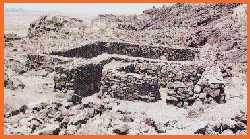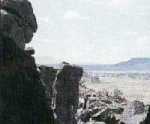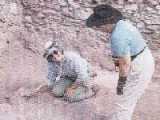
CASA MALPAIS ARCHAEOLOGICAL PARK
SPRINGERVILLE,
ARIZONA
|
You begin your journey into the past, and start to explore a lost civilization...
The diminutive but strong mountain people who lived here are called the "Mogollon." This Pueblo IV site exhibits similarities in pottery and architecture to the Anasazi of the Four Corners region. We know that Casa Malpais was occupied for about 100 years, and it was mysteriously abandoned about 1400 A.D. Casa Malpais, or "House of the Badlands", is surrounded by unusual beauty on a rim of volcanic rock overlooking the Little Colorado River's Round Valley. A breathtaking view of the White Mountains lies to the south. A "living archaeology" program affords opportunities for participatory education in excavation and laboratory work in the museum. The museum and field laboratory are open for visitation, and guided tours are available by contacting the museum. Membership in the local chapter of the Casa Malpais Archaeology Society enables the member to participate in special activities. Other activities offered to visitors include special lectures by site and visiting archaeologists and historians. Unique and unusual features characterize the site. The Great Kiva, painstakingly constructed of volcanic rock, is the centerpiece. A steep basalt staircase set into a crevice of the high red cliff wall leads to the top of the mesa.
Casa Malpais, A National Historic Landmark Site, is located on U.S. Hwy 60 in Springerville, Arizona (population 2000). Within 30 miles of this photogenic Mountain Valley, you will find great waterskiing, windsurfing, and petroglyphs at Lyman Lake State Park, excellent lake and stream fishing, campsites galore, historical museums, hundreds of acres of National Forest offering tall pines and herds of elk and antelope, a variety of restaurants and accommodations, and genuinely friendly people. The Smithsonian Magazine wrote: "A new door opening in Anthropology." And from the New York Times: "Few sites of pre-Columbian life in North America explored in recent years have aroused so much curiosity and excitment..." Newsweek Magazine said: "If past digs are any guide, this one could prove invaluable for understanding the Southwest's Indians." And from the Dallas Morning News: "What may have been a prehistoric regional trading center is the Southwest's hottest archaeological project..."
The Hopi and Zuni people claim an affinity to the site, and they are consulting with the museum and archaeologists to assure that our work is conducted with sensitivity toward Native American beliefs and customs. Some aspects of the site are closed to tours due to their sacred nature.
Today, tours of
the site are given Tues-Sat, at 9, 11, and 2, weather permitting,
from March through November.
Be sure to bring hiking shoes, hats, and water, as the trail
is steep and rocky at times.
Arrive 15 minutes early to see a video about the site before
the tour begins. It’s a
good idea to call for reservations, as the tours fill up quickly,
especially in the summer months.
The Museum, which
houses artifacts from the excavation, is open year round, from 8-4,
Monday through Saturday.
For more information,
visit casamalpais.org, or call 1-928-333-5375
email:www.casa@springervilleaz.gov
|
 As You Ascend The Terraces
To Casa Malpais...
As You Ascend The Terraces
To Casa Malpais... From this vantage point, at an
elevation of over 7,000 feet, you'll experience a dramatic overview of the
entire pueblo. Natural fissures are located throughout the site. Evidence shows
that these fissures were used for religious ceremonies as these people of the
mountains struggled with the complexities of life and death in their harsh
environment.
From this vantage point, at an
elevation of over 7,000 feet, you'll experience a dramatic overview of the
entire pueblo. Natural fissures are located throughout the site. Evidence shows
that these fissures were used for religious ceremonies as these people of the
mountains struggled with the complexities of life and death in their harsh
environment.  The first visit to Casa Malpais by a
professional anthropologist was in 1883, when Frank Cushing, an anthropologist
living at Zuni, visited a site at "El Valle Redondo on the Colorado Chiquito",
and was impressed by what he termed "the fissure type pueblo" he found there.
In his journal he sketched dry masonry, bridging fissures, upon which the
pueblo is constructed.
The first visit to Casa Malpais by a
professional anthropologist was in 1883, when Frank Cushing, an anthropologist
living at Zuni, visited a site at "El Valle Redondo on the Colorado Chiquito",
and was impressed by what he termed "the fissure type pueblo" he found there.
In his journal he sketched dry masonry, bridging fissures, upon which the
pueblo is constructed.